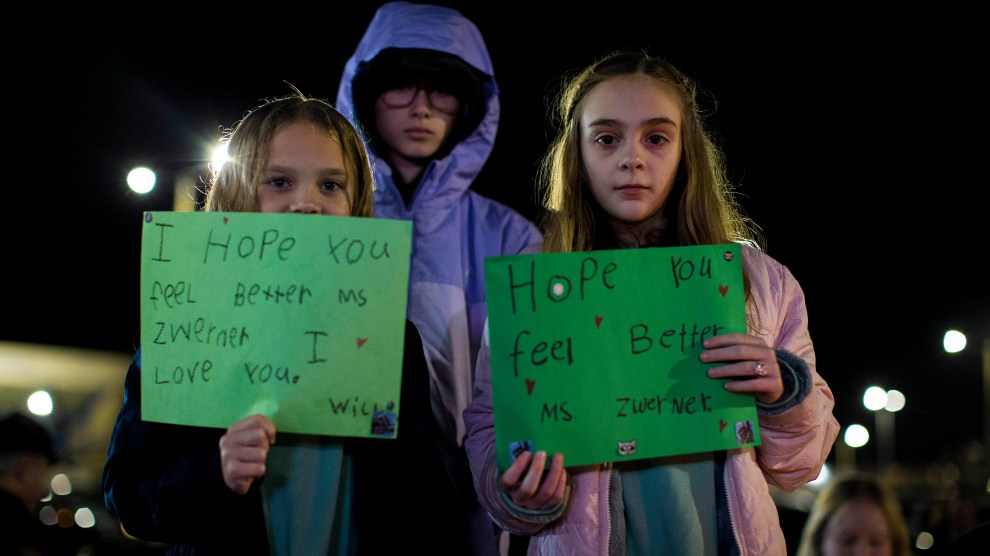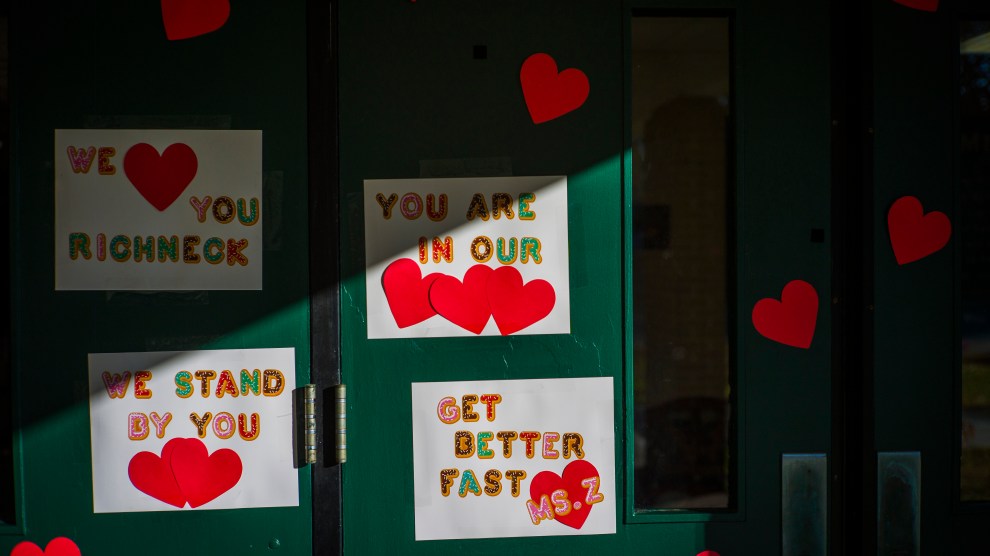
Mother Jones illustration; Getty
Ever since a 6-year-old boy shot his teacher in early January at a Virginia elementary school, the case has been difficult to comprehend. That starts with the bewildering youth of the child, who authorities said intentionally fired a pistol he’d brought to class at 25-year-old Abigail Zwerner, seriously wounding her. The high-profile case is also driving misconceptions about school shootings and how to improve school safety, exacerbated by a conspicuous lack of context on the tragedy.
Federal education law protecting the privacy of minors is in part hindering public clarity about the case, while some of the information that has emerged so far from local officials and the boy’s family has only raised further unsettling questions. At issue are the child’s mental and behavioral health, failures of school safety, parental responsibility, and gun laws.
After police investigators spoke with the boy and his mother in the immediate aftermath, Newport News police chief Steve Drew announced that the Taurus 9mm pistol fired by the boy inside his first grade classroom was legally purchased by the mother, who had brought her son to Richneck Elementary that morning. “We determined that the firearm was in the residence where they lived, and the child obtained that firearm, placed it in his backpack and brought it to school,” Drew said during a Jan. 9 press conference.
District superintendent George Parker later revealed that “at least one administrator was notified of a possible weapon” in the child’s possession prior to the violence. Parker also said that a search of the boy’s backpack that day by unspecified school personnel had come up empty. Newport News police were not notified about the possible gun prior to the shooting.
Authorities have not disclosed the identity of the family and their child, who was taken to an area hospital under an emergency order after police apprehended him at the school. As of late last week, the boy remained under evaluation in state custody and had engaged in no further contact with his parents since Jan. 6, the day of the shooting, according to reporting from the local Daily Press. Meanwhile, local and federal authorities searched two homes belonging to the family of the boy late last week, the Daily Press reported.
Last Thursday, the family issued a lengthy statement through an attorney. It stirred sympathy but is perplexing on more than one count. (Read the full statement here, which was first published by local TV news station WAVY.) The family began by expressing grief and prayers for Zwerner and by stating that they were cooperating with local and federal law enforcement “to understand how this could have happened.” They said they wanted to share additional facts “in hopes that they may ease the dissonance we are all grappling with and prevent something like this from happening again.”
They went on to highlight extraordinarily challenging circumstances with their child:
Our son suffers from an acute disability and was under a care plan at the school that included his mother or father attending school with him and accompanying him to class every day. Additionally, our son has benefitted from an extensive community of care that also includes his grandparents working alongside us and other caregivers to ensure his needs and accommodations are met. The week of the shooting was the first week when we were not in class with him. We will regret our absence on this day for the rest of our lives.
The parents’ highlighting of their child’s “acute disability” seems to suggest that the shooting may have been caused by that unidentified condition. We don’t have enough information in this case to evaluate such an explanation—but it would warrant sharp scrutiny. As I document in Trigger Points, my book about preventing school and mass shootings through the emerging field of behavioral threat assessment, the common belief that such planned attacks arise fundamentally from mental illness is wrong. Millions of people suffer from clinically diagnosable mental health afflictions, but decades of research have shown that there is no meaningful link, causal or predictive, between mental illness and violence, let alone in a person so young. Whether intentional or not, the implication that a young child’s disability is responsible for such a shooting could reinforce a damaging stigma for countless individuals with clinical conditions who never commit violence.
On Saturday, the Washington Post reported allegations from teachers that the boy had a history of violently disruptive behavior at the school. Those included him allegedly writing a note to a teacher in which he threatened to light her on fire and “watch her die,” a separate incident in which he “threw furniture and other items” in class, and another in which he “barricaded the doors to a classroom, preventing a teacher and students from leaving.” Zwerner herself had raised alarms about the 6-year-old and sought assistance during the school year, the Post reported.
According to threat assessment experts I spoke with and my extensive case research for Trigger Points, most violently disruptive actions seen in young schoolchildren stem from emotionally impulsive—that is, reactive—behavior, rather than from planned, predatory behavior. A threat case with a high risk for targeted violence plotted and then carried out by a 6-year-old would be extraordinary.
The tragedy at Richneck Elementary remains fraught with questions of systemic failure regarding both the family and the school. How did the boy actually get his hands on the gun and know how to use it? Who indicated to school officials in advance that he might have a weapon? What safety protocols did the school system have in place, and why didn’t school officials find the gun with their search? What if any action did they take after that result?
Neither the family nor local authorities have provided clear answers.
“Our family has always been committed to responsible gun ownership and keeping firearms out of the reach of children,” the family asserted in its statement last week. “The firearm our son accessed was secured.”
The mother’s attorney, James Ellenson, said in an interview with the Virginia Pilot late last week that the mother had a trigger lock on the gun. She stored it “out of reach of the child,” Ellenson said, “on the top shelf of a closet.” Ellenson declined to speculate as to how the boy obtained the weapon or overcame the trigger lock. “I don’t think any of us know,” he said. “We don’t know… She has no idea how the child got the gun.”
School district officials have not responded to questions from reporters seeking further details about the case and the safety failures at Richneck Elementary.
A decade ago, Virginia became the first state in the nation to mandate threat assessment policies and procedures for its K-12 public schools. The state has been a leader for the emerging violence-prevention work, but also an epicenter in recent years for high-profile gun tragedies. There have been three shootings on school grounds in Newport News since late 2021, according to the Post.
Michelle Price, a spokesperson for Newport News Public Schools, told me the district “is in compliance” with Virginia law requiring threat assessment in schools. Citing the federal education privacy law known as FERPA, she declined to comment on whether the 6-year-old shooter was the subject of a threat assessment case. She also declined to comment on any actions school officials took after learning that the boy might have a gun at school.
Gun tragedies in which young kids pull the trigger occur far more frequently than most people realize. Most are accidents. But even in the less common cases where such acts are deliberate, experts say a young child isn’t capable of criminal intent. “It is utterly inconsistent with science and what we know about human development and child development,” Marsha Levick, cofounder of the Juvenile Law Center, told the Associated Press. As a recent Washington Post story recounted, a Michigan prosecutor who handled a case involving a 6-year-old shooter more than two decades ago concluded after spending time with the boy: “This kid’s a baby. He doesn’t have the ability to form an intent to commit murder.”
“Most 6-year-olds lack the executive functioning skills that would be required to make a threat that could be considered substantive,” Nancy Rappaport, a child psychiatrist and threat assessment practitioner in Boston, wrote last week. “Without easy access to a weapon, a shooting requires planning and mobility that most first-graders simply do not have.”
Shortly after the Richneck shooting, authorities said the boy would not be charged with a crime but that it was too early to determine whether they might charge anyone else in connection with the violence. Questions of possible criminal liability come at a time of heightened focus on the issue, thanks in part to unprecedented manslaughter charges against the parents of the 15-year-old perpetrator of the November 2021 mass shooting at Oxford High School in Michigan. Those parents purchased the gun used by their son, fled from law enforcement in the aftermath, and stand accused of willfully ignoring an array of disturbing warning signs.
Virginia has no safe storage laws for guns. Michigan doesn’t either. While schools overall remain among the safest places for children to be in America—despite rising fears since Uvalde—most school shootings and gun accidents involving kids occur with weapons obtained in homes.
The Newport News school board is now focused on installing a bevy of “state of the art” metal detectors, beginning at Richneck Elementary, and Republican Gov. Glenn Youngkin has called for more cops in Virginia schools. Elected officials have pursued these kinds of reactive policies ever since the Columbine massacre in 1999. Recent years have also featured a push for armed teachers and the now-ubiquitous lockdown drills. Nonetheless, school shootings have significantly increased.
As I wrote recently, the case evidence from a spate of horrific mass shootings last year makes more clear than ever that America needs to shift away from a heavy overemphasis on the “target hardening” of physical security measures. With the country now processing another spasm of high-profile mass shootings—this time in southern and northern California—it is further evident that transforming public places into fortresses isn’t a desirable or realistic solution.
In a nation with an estimated 400 million firearms, which will remain easy to acquire in many regions for the foreseeable future, real progress can come with far more emphasis on early intervention measures and other forms of constructive prevention. That can include proven regulations such as stronger background checks, safe storage requirements, and red flag laws, which are designed specifically to keep guns away from people turning dangerous and are now backed by promising research. Real progress can also be built on broader use of quality threat assessment programs, which have already saved numerous lives throughout the country, including those of teachers and schoolchildren.
Update, Jan. 25, 10:30 a.m. PT: Additional reporting from the New York Times adds to disturbing questions about how school officials handled alleged warnings from school staff and threats made by the 6-year-old boy prior to the shooting: “School leaders were warned three times that the boy might have a gun, a lawyer for the teacher said on Wednesday, including by a student who tearfully recounted seeing the gun at recess.”
The story also specifies that the employee who searched the child’s backpack was a teacher. “No gun was found, but the teacher reported to the school administration that she believed the boy had put the gun in his pocket before going outside for recess,” the Times reported. “Instead of searching the boy, [Zwerner’s lawyer] said, an administrator dismissed the threat, saying that the 6-year-old ‘has little pockets.'”
About an hour before the shooting, another teacher reported “that a student had come to the teacher crying, saying that the boy had shown him the gun at recess and threatened to shoot the student if he told anyone,” Zwerner’s lawyer said, according to the Times.















